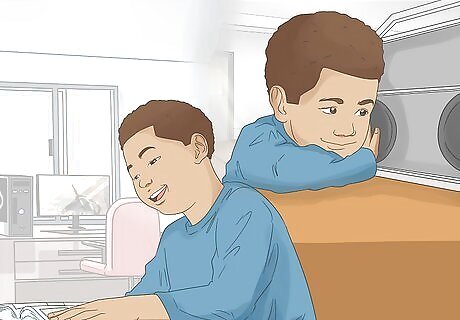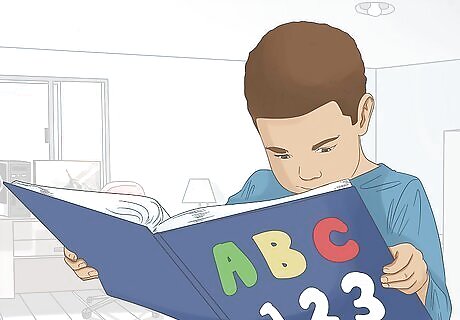
views
Observing Your Child in Action

Watch how your child expresses themselves. When a child is more comfortable learning in a certain style, they will also be more expressive through that same style. For instance, auditory learners express themselves best through words. At times, it may seem as if auditory learners aren’t paying attention because they are always trying to talk over you. Kids who are auditory learners also have a tendency to read out loud instead of quietly to themselves. Visual learners are more apt to express themselves and reveal their emotions through facial expressions, and may seem to be always watching others’ faces. By watching others, a visual learner is actually storing these images for future use. Kinesthetic learners express themselves through body language, and may seem unable to keep their hands to themselves. They often imitate others, particularly when it comes to movement (such as hand gestures and walking style). Also, these types of learners don’t worry about getting their hands dirty. They like to touch everything, including people and objects.

Consider your child’s interests. A child’s primary learning style is also normally reflected in their interests. For instance, auditory learners usually show an interest in music and sounds. They may be able to remember all the words to numerous songs, while possibly struggling to remember what they just read in a book. They may be easily distracted by noises and loud sounds, usually find games and activities far more exciting when music is involved, and probably love music class in school. Visual learners often have interests both in reading and watching TV, due to the common thread of visual stimulation. They may also enjoy looking at photographs and other interesting objects. Visual learners often have extensive vocabularies (due to their time spent reading) and may have imaginations that are equally large. Look for an interest in physical activities with kinesthetic learners. They like to do everything from swimming and running to playing baseball or basketball. Gym or art class may be kinesthetic learners’ favorite subjects, as they are able to keep their hands busy. These types of learners also enjoy games, but often can’t sit still long enough to read.

See how your child solves problems. We all draw from our strengths when attempting to solve problems, so kids tend to utilize the attributes that correlate to their learning styles. Auditory learners tend to talk through and discuss possible solutions to problems, for instance. You may hear them mumbling to themselves as they tackle homework assignments, or they may ask you to help talk them through a tough math problem. Visual learners use their eyes to solve problems, which means they quickly notice if something is out of place or amiss. They often excel at matching games or anything that tests their ability to look at something and identify changes at a later point in time. They also tend to keep a neat and tidy room, as they are quick to observe things that are out of place. Kinesthetic learners will usually try to solve problems with their hands. For instance, they may count with their fingers while trying to solve math problems. They often like flash cards as a learning tool, since they can interact with and touch the cards. They often love science projects and building contraptions meant to do a specific task.
Identifying Other Clues

Make cautious assumptions based on genetics. Blanket assumptions should always be avoided when it comes to children and especially how they learn; there are plenty of exceptions to every rule. However, there is good evidence that females are more likely to be auditory learners, while males tend to be visual learners. Factor this into your initial assessment, but don’t write it in stone. Even as babies, girls are often more responsive to sounds and learn to talk earlier (because they listen more intently), and they tend to take up reading more quickly once in school. Boys are often more visually alert as babies and tend to pick up on spatial concepts like spelling and math more quickly. But again, don’t make simplistic assumptions. If you want to avoid assumptions based on “girls are better at this, boys are better at this” evidence, focus more on the reality that learning styles run in families. Most children will have a learning style that matches that of one parent, or occasionally may have a blend of styles from both parents. So, if you can identify both yourself and the child’s other parent as visual learners, there is a good chance that the child is one as well.

Talk to teachers and people who interact with your child regularly. No matter how active you are as a parent or how closely you observe your own child, sometimes other people will pick up on tendencies and indications that you miss. A daycare provider, preschool teacher, or pediatrician (to name a few examples) may be able to provide keen insights into your child’s learning tendencies. You’ll want your kid’s teachers to be involved in shaping your child’s learning experience after you determine his or her learning style anyway, so involve them earlier in the process as well by asking for their insights on your child. A preschool teacher, for instance, may be able to tell you that your child understands the notion of subtraction best when visual cues (like blocks) are used; tends to repeat what they have just heard as a mechanism for remembering; or thrives in hands-on learning activities. Such qualities provide strong clues for a dominant learning style.

Ask your child to take multiple learning-style quizzes. Unless there is a concern about a potential learning disability or other issue, a child’s learning style is not something that typically needs to be professionally diagnosed. If you are content as a parent with a “more than likely” assessment based primarily on your own knowledge of your child, you may want to take several quizzes that can help provide initial indications. Search reputable child- and family-focused websites for short, multiple-choice tests about your kid’s habits and behaviors. You’ll encounter questions similar to: “While in the waiting area prior to a doctor’s appointment, your child … A) colors or draws pictures in relative silence; B) spends most of the time talking to you and possibly others in the room; C) unloads the box of toys in the waiting room and quickly shifts interest from one item to another.” For a question like the above, answer “A” indicates a visual learner, “B” an auditory learner, and “C” a kinesthetic learner. The results may vary from quiz to quiz, so it’s a good idea to have your child do multiple quizzes to determine which result they receive most frequently.
Acting Upon Your Findings

Match your child’s learning style with your teaching style. Whether you homeschool your child or just provide help with homework it’s helpful to match your teaching style to your child’s learning style. The best way to teach auditory learners is through verbal instruction and reading out loud. You should also incorporate songs or music into your teaching style. For example, if you want them to memorize a scientific equation, try putting it into a song. The best way to teach visual learners is through visual aids, flashcards, and educational videos. For example, if you are trying to teach them state capitals, draw (or print) a map of the U.S., outline the states, and indicate where the capitals are located. The best way to teach kinesthetic learners is by allowing them to do hands-on projects. For example, if you’re trying to teach them about volcanoes, have them build an actual model of a volcano.

Find programs that cater to your child’s strengths. When choosing an educational program for your child, find one that complements their learning style. For auditory learners, traditional educational programs tend to work best. However, you may also want to consider enrolling your child in an educational program which focuses on music or has a strong music department. If there are magnet schools in your area, look for one that specializes in music. For visual learners, traditional educational programs also work well. However, in some areas there are magnet schools which focus on the visual and performing arts. For kinesthetic learners, a Montessori program may fit their learning style best. These types of programs take a more hands on approach to learning. You can find Montessori programs in your area by conducting a search online for “Montessori schools near me.”

Teach your child to study based on their learning style. In addition to choosing the right teaching method and educational program to suit your child’s learning style, it is equally helpful to teach your child how to study based on that style. For auditory learners, have them create rhymes to memorize information, such as facts and dates. If possible, have them record lectures so that they can study by listening to the recordings. For visual learners, have them use flashcards when memorizing information. They can also study using their textbooks, particularly ones with graphs, pictures, and charts. For kinesthetic learners, have them use flashcards to study, particularly when learning facts, dates, and processes. Encourage them to take breaks when studying, as they need more time to process information (and often to release pent-up energy).

Don’t completely limit your child to a single learning style. Some children may have a combination of learning styles, so don’t expect them to completely identify with a single style. Also, a well-rounded individual needs to be able to acquire and utilize information in a wide range of ways, including through listening, looking, and doing. Complement the child’s learning style with elements of the other major styles. Utilize flash cards with auditory learners and read aloud to visual learners. Help kinesthetic learners recognize that not every learning activity can be hands-on. Learning styles are not set in stone, and can sometimes shift as a child develops and matures. So don’t assume that an auditory learner will always be strictly so; expose them to other learning styles all along the way.




















Comments
0 comment